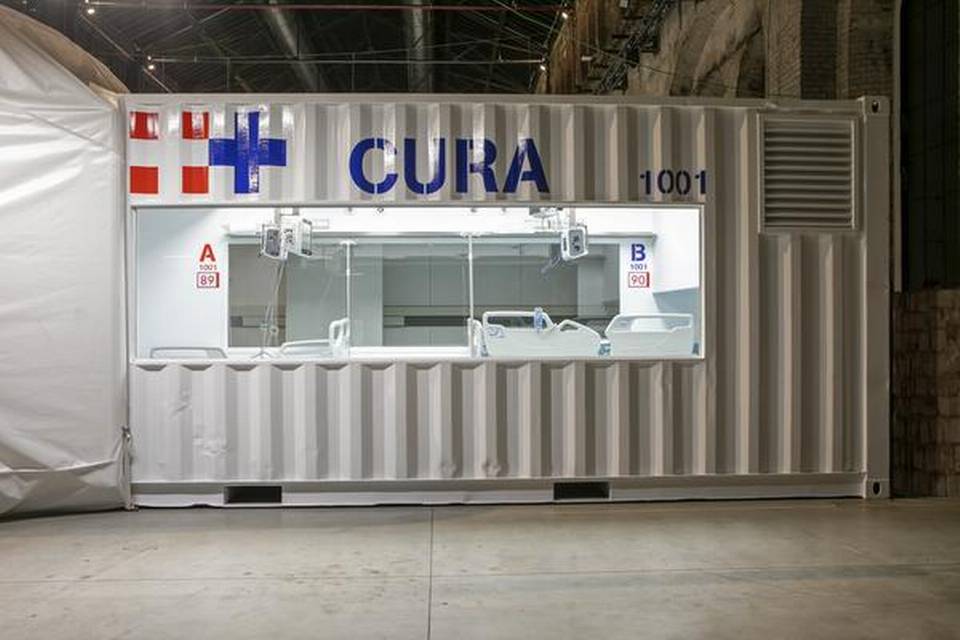In conversation with the two designers who worked on the Connected Units for Respiratory Ailments (CURA), aimed at reducing the risk of cross-infection for doctors and nurses
In early March, as the Covid crisis was spreading across the world, Italian architects Carlo Ratti and Italo Rota of Carlo Ratti Associati were busy converting shipping containers into Connected Units for Respiratory Ailments, also known as CURA (Latin for ‘cure’) care pods. On April 18, four weeks after the launch (on March 24), the global open-source initiative’s first unit was installed at a temporary hospital in Turin, Italy. CURA is a quick-to-deploy solution aimed at expanding emergency facilities to ease the pressure on healthcare systems that treat patients infected by the novel coronavirus.
The pods have been developed by the duo along with an international task force of professionals from the engineering firm, Jacobs, and the health technology company, Philips, for medical equipment supply.
Carlo Ratti, founder of Carlo Ratti Associati is also director, MIT Senseable City Lab. Rota is an architect, lecturer and scientific director of NABA, New Academy of Fine Arts in Milan, and founder of Italo Rota Building Office. Excerpts from an interview:
Can you share some details of the care pod’s designs
Carlo: CURA is a compact intensive-care pod for patients with respiratory infections, hosted in a 20-foot intermodal container with bio-containment (using negative pressure). The pod contains all the medical equipment needed for two ICU patients, including ventilators and monitors as well as intravenous fluid stands and syringe drivers. The two glass windows carved on the opposite sides of the containers are meant for doctors to check the status of patients, both inside and outside the pods. Also, this would potentially allow visitors to get closer to relatives in a safer and more humane setting. Each unit works autonomously and can be shipped anywhere.
Individual pods are connected by an inflatable structure to create multiple modular configurations (from 4 beds to over 40), which can be deployed in just a few hours. Some pods can be placed in proximity to a hospital (in parking lots, for example) to expand the ICU capacity, while others could be used to create standalone field hospitals of varying sizes. The units could be as fast to mount as a hospital tent, but as safe as an isolation ward, thanks to bio-containment.
How long did it take to come up with the complete design?
Carlo: We went from sketch to executive design to prototype fabrication in around three weeks. With the first unit now built in Northern Italy, the next step will be scaling up, and this will happen in a distributed way, thanks to the 2000+ people and companies who are now engaged in the open-source community.
Italo: CURA is the product of a task force of designers, engineers, medical professionals, and consultants. Following an open-source approach, we made all the technical specifications and drawings available for all those who want to replicate it or develop it further. It has been impressive, in just a few weeks, to see teams of fabricators spring to action all over the world.
Please tell us the specs of the first unit set up in Turin.
Italo: It is exactly like a small hospital room, with all standard medical equipment necessary for an ICU, particularly for respiratory infections. In Italy, as of now, an increasing number of COVID-19 cases are occurring among medical professionals. For this reason, the room will guarantee a level of biosafety, by using negative pressure for bio-containment. This would allow us to reduce the risk of cross-infection for doctors and nurses.
When will it be released commercially?
Carlo: The CURA design has been developed in an open-source, not-for-profit framework, and is accessible to all. The production of pods for sale has already started in different parts of the world. We are also collaborating with the fabricators of the first unit in Italy, who have already invested in a large production line.
How much does it cost to build a single CURA?
Italo: The cost can vary depending on the number of units and the project specifications, but it is around $75,000 per bed, including the medical equipment.
How has the design been received?
Carlo: In fewer than 48 hours from the initial launch, we received requests for collaboration from across the world: from suppliers and designers to producers of shipping containers to funding programmes.
Tell us about the role that architecture plays during crisis situations.
Carlo: Architecture and design need to constantly explore how the built environment can be transformed. This is particularly important at a time of crisis, when the boundary conditions of our lives immediately change. Today, designers’ responses need to deal with managing an emergency, but tomorrow they will need to deal with imagining healthier and more sustainable cities.

